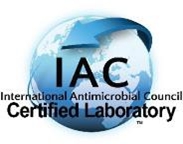Attached files
Exhibit 99.2

September 8, 2017
| To: | Max Munn Max Munn, LLC |
50 N. Macquesten Parkway
Mount Vernon, NY 10550
| From: | Matthew Hardwick, PhD |
ResInnova Laboratories
8807 Colesville Rd, 3rd Floor
Silver Spring, MD 20910
Dear Mr. Munn,
Enclosed you will find the summary analysis report for the recent antimicrobial testing of two UV-emitting mirror prototypes. The wall-mounted mirrors were tested for their ability to kill three healthcare-relevant bacteria: Clostridium difficile spores (C diff), Escherichia coli (E coli), and methicillin-resistant Staphylococcus aureus (MRSA). Testing occurred over several time points and samples were placed in various locations on a vanity/sink.
Within this report, you will find the graphs summarizing the data. A great deal of data was generated during the course of this project that did not end up in this report. All data is available for your review should you request it. The conclusions drawn from this project are listed on the last page of this report. Please notify me if you wish additional testing of this material and/or further analysis of the results contained within this report.
Sincerely,
/s/ Matthew Hardwick, PhD
Matthew Hardwick, PhD
President and CEO


Exhibit A
Final Report
Purpose
We performed antimicrobial testing of two UV-emitting mirror prototypes. The wall-mounted mirrors were tested for their ability to kill three healthcare-relevant bacteria: Clostridium difficile spores (C diff), Escherichia coli (E coli), and methicillin-resistant Staphylococcus aureus (MRSA). Testing occurred over several time points and samples were placed in various locations on a vanity/sink. The goals of this project were:
| 1. | Determine the antimicrobial efficacy of the mounted UV LEDs against C diff spores, E coli, and MRSA; |
| 2. | Determine the optimal operating conditions to kill 4 logs (99.99%) of each bacterium. |
Materials and Methods
UV-emitting Mirrors (provided by Max Munn)
| • | Prototype 1 with a UV LED strip mounted parallel to the bottom of the mirror and recessed from the bottom of the mirror. A UV LED strip was also mounted inside the mirror. |
| • | Prototype 2 with a UV LED strip mounted flush with the bottom of the mirror at an approximate 45° angle facing away from the mirror. |
Bacteria
| • | Clostridium difficile (C diff) spores (ATCC BAA-1870) |
| • | Escherichia coli (E coli) (ATCC 25922) |
| • | Methicillin-resistant Staphylococcus aureus (MRSA) (ATCC 33591) |
Bacterial Sample Preparation:
| • | C diff: Approximately 1 x 106 spores were plated onto magnetic steel discs and allowed to dry. |
| • | E coli and MRSA: A thin layer of tryptic soy agar was plated onto magnetic steel discs and allowed to dry. Then, approximately 1 x 106 colony forming units (CFUs) were layered on top of the agar. |
| o | The agar layer was necessary as plating E coli and MRSA directly onto magnetic steel discs resulted in poor bacterial recovery. |
Sample placement:
| • | Samples were placed on several locations on a vanity/sink. See Figure 1 for placement and overall setup. |
Bacterial Recovery and Evaluation:
| • | At the indicated time points, discs were recovered into a labeled 15ml tube containing 10ml phosphate-buffered saline (PBS) + 0.1% Trion X-100 and vortexed for 1 minute. 0.1ml of the recovery solution was then transferred either onto agar plates (see below) or into dilution tubes for further dilution. Agar plates were then incubated for 24 to 48 hours. Log reductions were determined by comparing colony numbers from test samples to control samples (samples not exposed to UV). |
| o | C diff: brain heart infusion agar with incubation in an anaerobic chamber at 37°C. |
| o | E coli and MRSA: tryptic soy agar with incubation in a humidified chamber at 37°C. |


Exhibit A
Figure 1: Testing Setup and Sample Placement
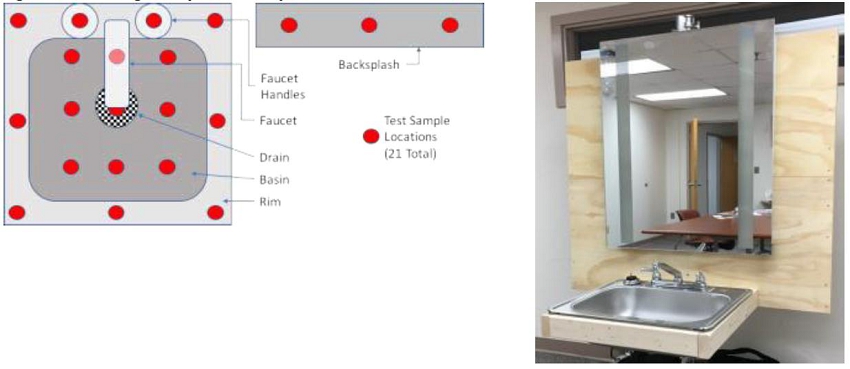
Results
We tested the bacteria killing ability of two Max Munn UV-emitting mirror prototypes. The first prototype we received demonstrated robust reduction of spore viability on backsplash surfaces. The compiled results after testing of both prototypes are presented in Figure 2. After one hour exposure, reductions approached 3 logs (99.9%) and surpassed 4 logs (99.99%) after 2 hours (Figure 2, Backsplash). This first prototype, however, had several deficiencies as it failed to reduced spore viability on faucet handles and on surfaces greater than 7 inches from the light source. It was decided by Max Munn to create a new prototype based on these results and we discontinued testing on the first prototype.
The second prototype increased the reach of the UV achieving a 2.94 log reduction of C diff spores on the sink side edges (the rim of the sink approximately 14 inches away from the light source) after 2 hours. The second prototype also improved UV exposure to faucet handles achieving greater than 4 log spore reductions were seen after just 1 hour and 3.5 log reductions were seen at the sink drain after 2 hours of exposure. This prototype also showed a 3.56 log reduction in spores at the sink drain (no reductions were seen in the first prototype). No reductions were seen in the sink at points immediately adjacent to the sink wall proximal to the UV source or on the distal sink edge (data not shown). This prototype also failed to deliver adequate UV to the backsplash (data not shown).
We were also able to test the ability of the second prototype to kill both E coli and MRSA. Testing against E coli demonstrated greater than 4 log reductions for both faucet handles and the drain after just 30 min (Figure 3). Regardless of how long we exposed the sinks to UV, the mirror failed to produce greater than a 1.9 log reduction on the edges of the sink (approximately 14 inches from the UV source). For the faucet handles and sink drain, MRSA results were similar to E coli, with greater than 4 log reductions seen within an hour of exposure to UV (Figure 4). On the sink side edges, however, MRSA demonstrated a greater than 4 log reduction after an hour of UV exposure. For neither E coli or MRSA were bacterial reductions seen in the sink at points immediately adjacent to the sink wall proximal to the UV source or on the distal sink edge (data not shown).


Exhibit A
Figure 2: UV Reduction of C diff Spore Recovery on Vanity/Sink Surfaces
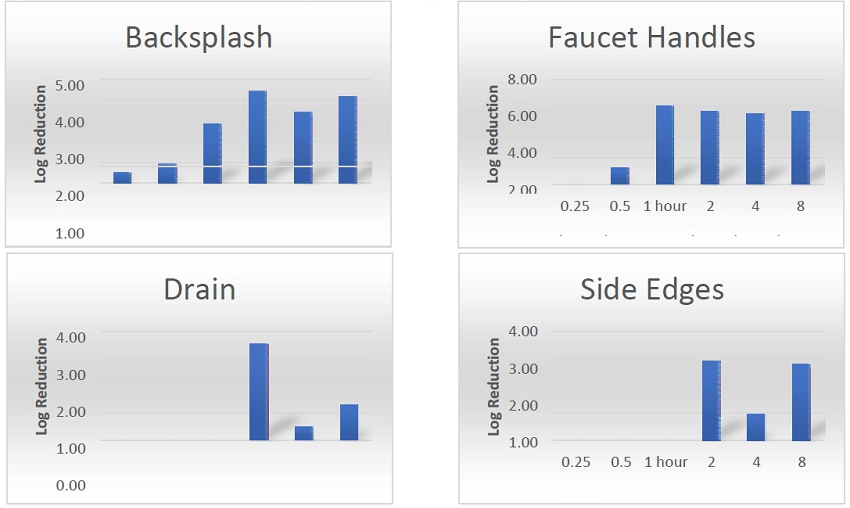
Figure 3: UV Reduction of E coli Recovery on Vanity/Sink Surfaces
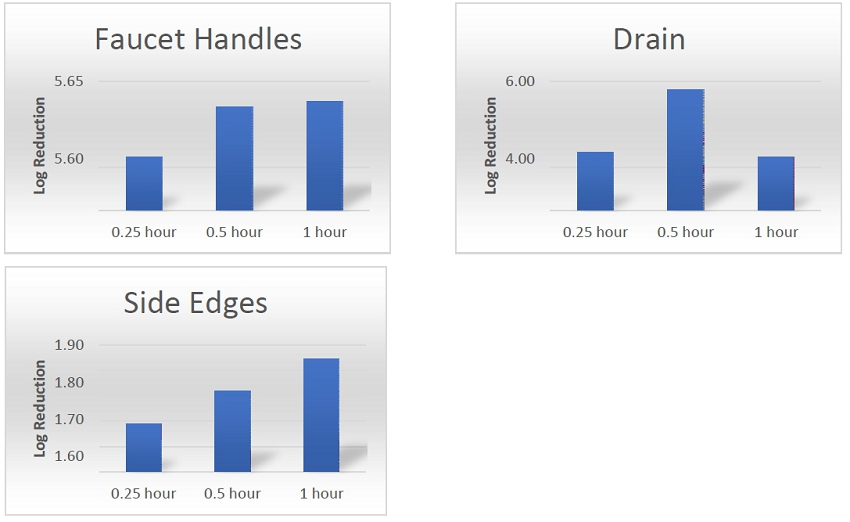


Exhibit A
Figure 4: UV Reduction of MRSA Recovery on Vanity/Sink Surfaces
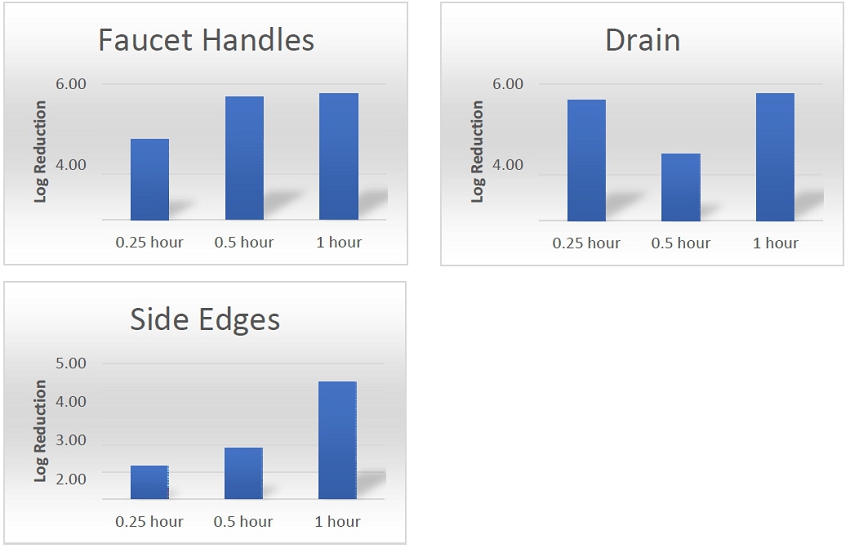
Discussion
There were several anomalous results during testing. Several data points seen in Figures 2 and 3 show that longer UV exposures do not improve bacterial reduction outcomes. This phenomenon is particularly true at the drain and sink edges for all three organisms. It should be noted that a major failing of all UV technologies is shadowing. For our simulated sink testing (Figure 1) we used a rotating faucet. It is possible that, for the drain test points, the faucet may have been moved relative to the position of our test sample resulting in a shadow effect that reduced the UV exposure at that test point. The sink we used for testing has beveled edges. Any shifting in the position of the sink edge test samples may have resulted in a dramatic effect on the UV exposure to the sample (another example of shadowing). Shadowing, however, does dramatically limit the utility of this technology on surfaces immediately adjacent to the sink wall proximal to the UV source and to surfaces greater than 22 inches from the UV source (data not shown). Regardless, there is ample evidence that significant bacterial reductions are achieved at critical areas such as the backsplash, faucet handles, drain and sink edges.


Exhibit A
Conclusions
| • | The first prototype demonstrated dramatic C diff spore reductions on backsplash samples: |
| o | Backsplash |
| ▪ | > 4 logs after 2 hour exposure. |
| • | The second prototype demonstrated dramatic reductions with C diff spores, E coli, and MRSA on several critical sink areas: |
| o | Faucet Handles |
| ▪ | C diff spores: > 4 logs after 1 hour exposure; |
| ▪ | E coli: > 4 logs after 30 minute exposure; |
| ▪ | MRSA: > 4 logs after 30 minute exposure. |
| o | Drain |
| ▪ | C diff spores: > 3 logs after 2 hour exposure; |
| ▪ | E coli: > 4 logs after 30 minute exposure; |
| ▪ | MRSA: > 4 logs after 30 minute exposure. |
| o | Side Edges |
| ▪ | C diff spores: almost 3 logs after 2 hour exposure; |
| ▪ | E coli: almost 2 logs after 1 hour exposure; |
| ▪ | MRSA: almost 2 logs after 1 hour exposure. |
| • | A 2 hour non-stop operation of the UV-emitting mirror should have a dramatic antimicrobial effect on the bathroom vanity/sink area. |
| • | Future prototypes that provide at least 2 UV LED units (1 placed as on prototype 1 and the other placed as on prototype 2) should provide adequate coverage of most areas of the bathroom vanity and sink. |
| o | Exceptions include the sink wall proximal to the UV LED units and areas greater than 22 inches distal to the UV LED units. |
| • | More testing is needed to conclusively determine the effect of the UV-emitting mirrors on organisms other than C diff, E coli and MRSA. |
| o | However, it may be reasonably assumed that the mirrors should be effective against other Gram-negative bacteria, such as Legionella pneumophila, and Gram-positive bacteria, such as Streptococcus species. |
